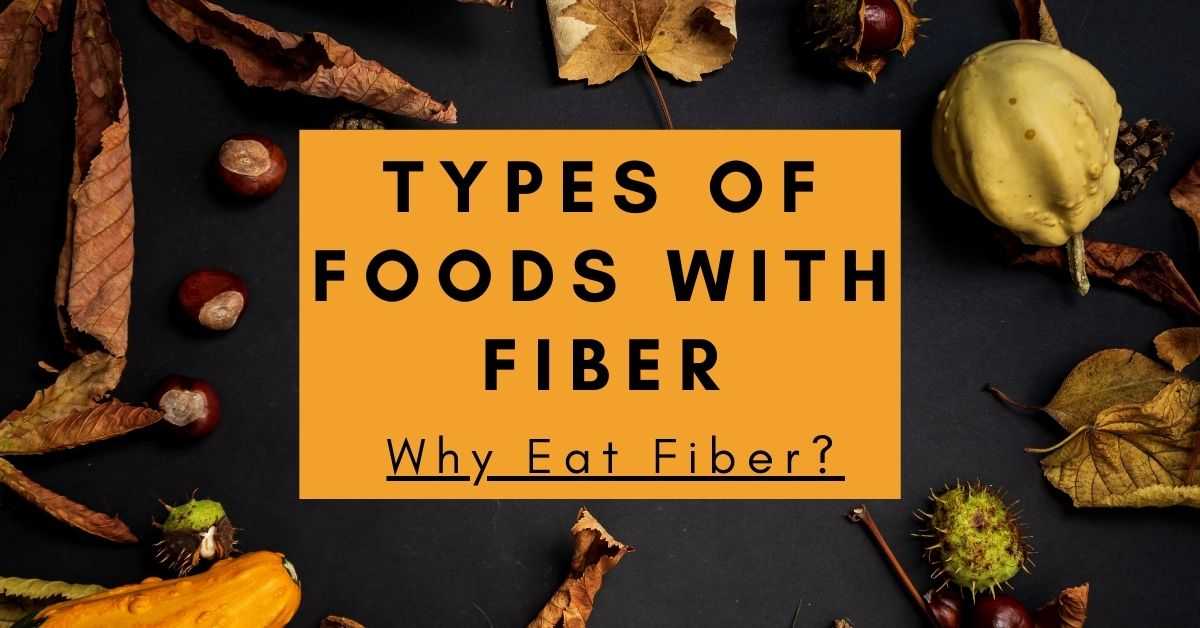Types of Foods with Fiber

This post may contain affiliate links. Please read our disclosure for more info. Now let’s look into types of foods with fiber.
Want to know different types of foods with fiber that can provide the most fiber? If Yes, you are in the right place!
Fiber is essential for your body as it helps in digestion and also reduces the risk of heart disease, diabetes, and obesity.
Therefore, Fiber is essential for your body.
So, let’s talk about how much fiber you need in a day. Men should consume 30 to 38 grams a day and women should consume at least 20 to 26 grams a day.
Below I have given a detailed chart for the fiber intake as per age group, where you can check if you are eating sufficient fiber or not.
It may look like a lot but you can fulfill their requirements by eating Fruits, Vegetables, Grains, Legumes, Nuts, and Seeds.
Contents
Types of Fiber you Should Know!
There are 2 categories of Fiber – Soluble, and Insoluble, So let’s look at those:-
Soluble Fiber
Soluble fiber and water-soluble fibers which are found inside plant cells. they slow down the time the food takes to digest so it can keep you full for a long time and will further help in weight management.
There is enough evidence the soluble fiber has helped in decreasing cholesterol and reducing blood glucose.
Insoluble Fiber
Insoluble fiber is in the cell walls and it does not dissolve in water. This fiber main function is to increase your stool volume and maintains your bowel movement.
Below I have talked about the types of foods with fiber so that you can maintain your daily fiber intake.
Fiber Intake by Age
Below are high fiber food Intake, based on information provided from the Colorado State University. All amounts are in grams.
| Age | g/Day Fiber |
| 1-3 years | 19 |
| 4-8 years | 25 |
| Males | |
| 9-13 years | 31 |
| 14-18 years | 38 |
| 19-50 years | 38 |
| 51+ years | 30 |
| Females | |
| 9-13 years | 26 |
| 14-18 years | 26 |
| 19-50 years | 25 |
| 51+ years | 21 |
| Pregnancy | 10 |
| <18 years | 28 |
| 18+ years | 28 |
| Lactation | |
| <18 years | 29 |
| 18+ years | 29 |
What fiber does for your body?
After talking about types of fiber, Now let’s talk about what fiber does to your body and why you should eat it.
Helps in Weight Loss
Both the Soluble and Insoluble fiber can help you in losing weight. The best way on using fiber to lose weight is to lower your carbohydrates intake and create a calorie deficit balance.
In simpler terms, It means eating fewer calories than the calories you daily burn.
Improves Your Heart
Scientific studies and trials have significantly shown that insoluble fiber from cereals and vegetables helps reduce the risk of heart problems and diseases.
Fiber also keeps the sugar levels under control and helps improve cholesterol levels. There is also evidence that fiber keeps your blood pressure in check if you are suffering from hypertension.
Helps in controlling Diabetes
When we consume fiber, It increases our insulin sensitivity which helps in reducing the risk of Type-2 Diabetes. Fiber foods have lower glycemic acid. which means it can keep blood sugar level under control.
Maintaining Healthy Bowel Movements
Fiber can significantly improve your bowel movements and all of the digestive health. It increases the weight of your stool and helps in softening it and makes it easier to pass and you will have fewer chances of constipation.
Helps Preventing Cancer
Several studies and research has found out that fiber helps in preventing colon cancer and breast cancer. Research also found out that, For every 10 grams of fiber, we consume per day, the risk of cancer is reduced by an impressive 9%.
Types of Foods with Fiber (High Fiber Foods List)
Below are high fiber food charts, based on information provided from the Mayo Clinic. All amounts are in grams.
High Fiber Fruits
| Fruits | Serving Size | Total Fiber |
| Raspberries | 1 Cup | 8.0 |
| Pear | 1 Medium | 5.5 |
| Apple | 1 Medium | 4.5 |
| Banana | 1 Medium | 3.0 |
| Orange | 1 Medium | 3.0 |
| Sandwiches | 1 Cup | 3.0 |
High Fiber Vegetables
| Vegetables | Serving Size | Total Fiber |
| Green peas, boiled | 1 Cup | 9.0 |
| Broccoli, boiled | 1 Cup Chopped | 5.0 |
| Turnip greens, boiled | 1 Cup | 5.0 |
| Brussels sprouts, boiled | 1 Cup | 4.0 |
| Potato, with skin, baked | 1 Medium | 4.0 |
| Sweet corn, boiled | 1 Cup | 3.5 |
| Cauliflower, raw | 1 Cup Chopped | 2.0 |
| Carrot, raw | 1 Medium | 1.5 |
High Fiber Grains
| Grains | Serving Size | Total Fiber |
| Spaghetti, whole-wheat, cooked | 1 Cup | 6.0 |
| Barley, pearled, cooked | 1 Cup | 6.0 |
| Bran flakes | 3/4 Cup | 5.5 |
| Quinoa, cooked | 1 Cup | 5.0 |
| Oat bran muffin | 1 Medium | 5.0 |
| Oatmeal, instant, cooked | 1 Cup | 5.5 |
| Popcorn, air-popped | 3 Cup | 3.5 |
| Brown rice, cooked | 1 Cup | 3.5 |
| Bread, whole-wheat | 1 Slice | 2.0 |
| Bread, rye | 1 Slice | 2.0 |
High Fiber Legumes, Nuts, and Seeds
| Legumes, Nuts, and Seeds | Serving Size | Total Fiber |
| Split peas, boiled | 1 Cup | 16.0 |
| Lentils, boiled | 1 Cup | 15.5 |
| Black beans, boiled | 1 Cup | 15.0 |
| Baked beans, canned | 1 Cup | 10.0 |
| Chia seeds | 1 Ounce | 10.0 |
| Almonds | 1 Ounce (23 Nuts) | 3.5 |
| Pistachios | 1 Ounce (49 Nuts) | 3.0 |
| Sunflower kernels | 1 Ounce | 3.0 |
BE COMMITTED TOWARDS YOUR HEALTH, YOU CAN DO IT!
This post may contain affiliate links. Please read our disclosure for more info.






